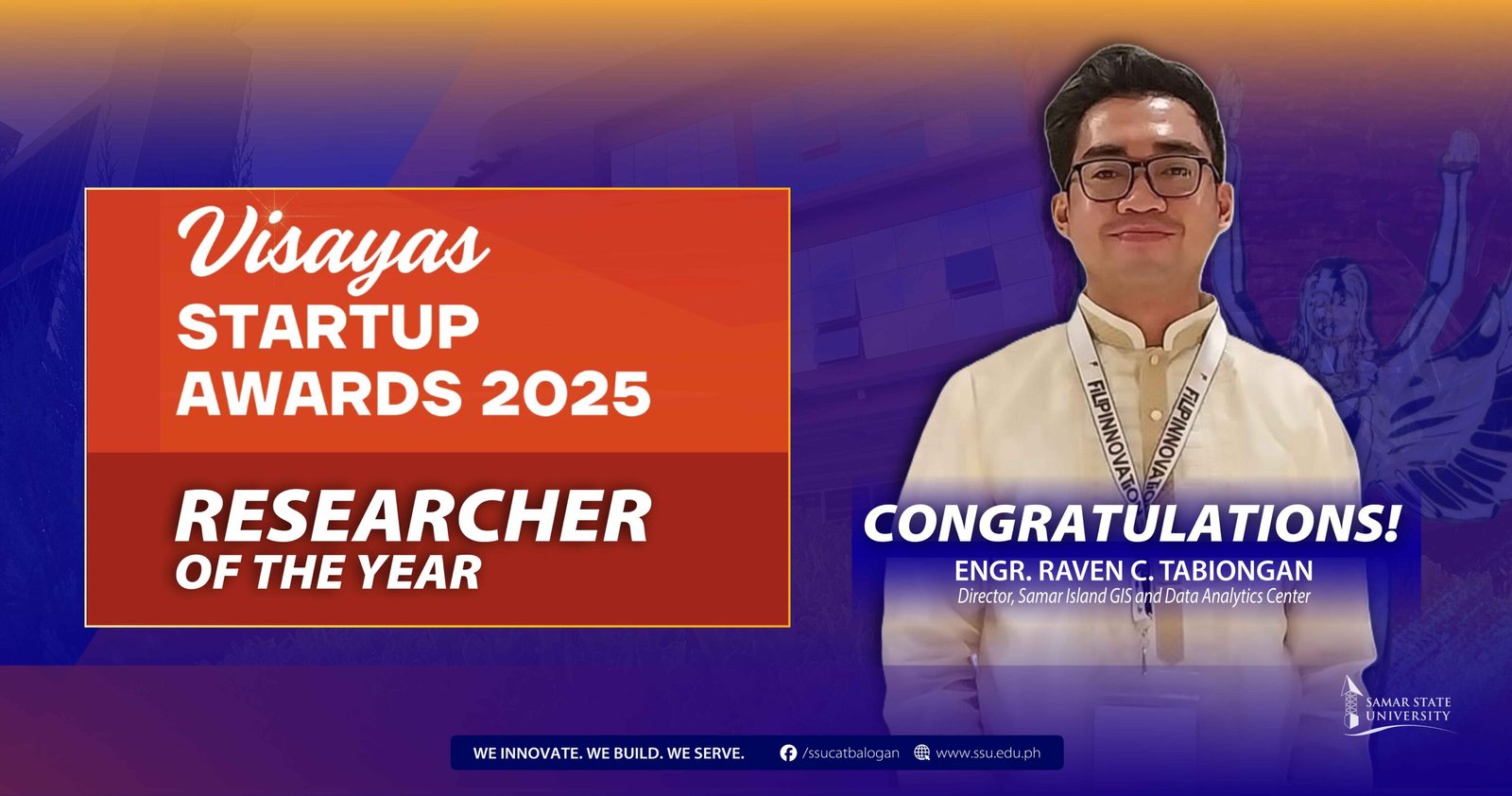TACLOBAN CITY, Philippines—On a stage built for innovators, Engr. Raven C. Tabiongan, Director of the Samar Island GIS and Data Analytics Center (SIGISDAC) and faculty member of the Samar State University (SSU) College of Engineering (CoEng), was hailed as the Researcher of the Year at the Visayas Startup Awards 2025, the capstone ceremony of the Innovation and Technology Transfer Summit held last September 4 and 5 at the Summit Hotel, Tacloban City.
The award was given by the Department of Science and Technology (DOST) Region VIII with the Wadhwani Foundation-Philippines. The “Researcher of the Year” distinction spotlights a scientist whose body of work moves beyond theory, and turn prototypes and publications to policies, projects, and products that Visayas communities can actually use.
Engr. Tabiongan and his team’s Project TANAW dominated the Innovation and Technology Transfer Summit alongside 18 other startup finalists, including the Farmyra, OIKOS ORCHARD & FARM, Fruitos, ThinkerVille, TalinoX, ArticuLit, NegoHack, IDiscount Philippines, C4U: Chores for You, TANAW, THEREALONE, ResQcomm, BioConnectify, Telerad.ph, CENTENO, RentHive Technologies Inc., NextStop, and PackUp.
Project TANAW
One of SSU’s main entries for this year’s summit, Project TANAW, an acronym for Topographical Analysis and Angular Assessment of City Works, is SSU’s pioneering effort to bring immersive 3D mapping, simulation, and augmented reality (AR) into urban planning and disaster resilience. Funded by the City Government of Catbaloga. It is designed as a simulation platform for Catbalogan City LGU on planning and more-responsive decision-making in fostering a resilient and sustainable city. The team launched the initiative at the Regional Smart Communities Exposition and Networking Engagement (RSCENE) last June 16 where DOST Secretary Dr. Renato U. Solidum Jr. himself saw the innovation.
The project introduces immersive 3D mapping, simulation, and AR projection into urban planning and disaster resilience. Funded by the City Government of Catbalogan, TANAW was designed as a decision-support tool for local government units. Its features include:
· A 3D-printed model of Catbalogan City integrated with geohazard simulations.
· Virtual environments and AR mapping to visualize disaster scenarios such as flooding and landslides.
· Geospatial technologies for infrastructure modeling, hazard assessment, and vulnerability mapping.
· High accuracy results (¬±5%) that identified 15+ critical infrastructure vulnerabilities and 10 high-risk zones.
· Strong user validation, with over 200+ stakeholders rating TANAW’s usability at 90%+ satisfaction.
TANAW Dev Team
Alongside his individual recognition, Project TANAW also won the Category Grand Winner Award at the summit. The achievement reflects the collective effort of the SIGISDAC team:
· Ar. Lhimarose Tanseco (Architect III)
· Catherine Carcellar, LPT (Project Development Officer)
· Yvonne Chui (Project Administrative Officer)
· Sonny Boy Ellema (Computer Programmer)
· James Cortel (Motion and Visual Effects Designer)
His award, alongside the Category Grand Winner award received by Project TANAW in the same ceremony, affirms the hard work of the Team in pushing geospatial science.
Leading SIGISDAC
As SIGISDAC director, Engr. Tabiongan has not only overseen TANAW, he has built SIGISDAC into a hub of grants and partnerships for applied geospatial research. The center provides services in mapping, data management, analytics, simulation, and helps local government units, communities, and academic stakeholders understand patterns, risks, and build policies based on data. Apart from Project TANAW, the center also leads the “Project GEOMAP (MAPULON App): Geospatial Mapping and Information System for Precise Farming and Smart Agriculture,” funded by the National Economic Development Authority (NEDA) Innovation Grant 2023.
As of recent, some of the center’s key achievements include the Grand Champion Award for Project TANAW during the Visayas Startup Awards 2025, the ShinMaywa Award at the Visayas TECH PLANTER 2025, semi-finalist for SAFE STEPS D-Tech Awards 2025, Engr. Tabiongan as Grand Winner at the Pitch Quest of 2024 Innovation and Technology Transfer Summit (Visayas), Best Presenter Award (Engineering Category) at the International Research and Innovation Conference on Education, Engineering, and Agriculture (IRICEEA) 2024, Grand Winner (MAPULON.IO) at the AMY Innovation Awards 2024, and won gold medals and international special awards during the 9th International Invention Innovation Competition (iCAN) 2024. These are only some of the recognitions garnered by the Team at SIGISDAC.
Researcher of the Year
DOST selected the Researcher of the Year at the Visayas Startup Awards based on impact beyond publication, scalability and usability, innovation and interdisciplinarity, and sustainability and relevance. Through Project TANAW, Engr. Tabiongan has exemplified all these qualities and proved that research anchored on science and technology can meaningfully shape policy, strengthen local governance, and safeguard communities in vulnerable regions like Samar.
“Individual awards may carry my name, but they belong to the team. These honors are testaments to the talent and persistence of the men and women of SSU-SIGISDAC. For me, there are no individual recognition, it is, and will always be, a team award,” – Engr. Tabiongan.
As a state university in Samar, this recognition directly resonates with SSU’s vision of becoming a premier university in the region and its mission to provide quality higher education, research, extension, and production services that are responsive to societal needs. Awards do not end the work; they expand the mandate. With this win, SSU continues its work on deepening LGU collaborations, mentoring the next wave of geo-innovators, and translating models into tangible and high-impact projects. This is the spirit that DOST calls for across its regional summits—research that doesn’t just survive peer review, but helps communities thrive.

